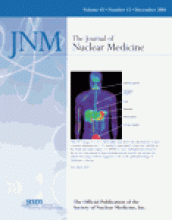Abstract
The aim of our study was to derive and to validate the normal threshold for an automatically measured left ventricular transient ischemic dilation (TID) ratio in patients referred for adenosine stress myocardial perfusion SPECT (MPS) and to assess the value of integrating TID in detecting severe and extensive coronary artery disease (CAD). Methods: Normal limits for the TID ratio were derived using dual-isotope MPS data from 38 patients with a low (<5%) likelihood of CAD. Criteria for abnormality were calculated on the basis of data from 179 consecutive patients who had undergone coronary angiography less than 3 mo after index adenosine MPS: 41 patients (23%) had severe and extensive CAD (≥90% stenosis) in the proximal left anterior descending artery or in 2 or more coronary arteries, 64 (36%) had no significant CAD (<70% stenosis), and 74 (41%) had mild or moderate CAD. The criteria were then prospectively validated in a cohort of 177 patients, of whom 41 patients (23%) had severe and extensive CAD, 55 (31%) had no significant CAD, and 81 (46%) had mild or moderate CAD. Results: By analysis of receiver-operating-characteristic curves, the best threshold for adenosine TID ratio abnormality was the mean adenosine TID ratio in the low-CAD-likelihood patients + 2 SDs (TID ratio > 1.36). Abnormal TID ratio using this threshold demonstrated high sensitivity and specificity for severe and extensive CAD (71% and 86%, respectively), and similar sensitivity and specificity were observed in the prospective validation group (73% and 88%, respectively). In the combined pilot and validation groups, the absence of both abnormal TID ratio and abnormal perfusion was highly specific for the absence of severe and extensive CAD; only one (1.3%) of 79 patients with severe and extensive CAD had neither of these abnormal findings on adenosine MPS. In patients with both abnormal TID ratio and abnormal perfusion, 55 of 84 (65%) had severe and extensive CAD. When patients had one but not both of these findings, 26 of 193 (13%) had severe and extensive CAD. Conclusion: The automatically measured TID ratio is a useful clinical marker that is sensitive and highly specific for identification of severe and extensive CAD in patients undergoing adenosine MPS. Integration of abnormal TID ratio into the dual-isotope MPS image interpretation algorithm improves the identification of severe and extensive CAD in adenosine MPS.
- clinical cardiology
- coronary artery disease
- myocardial perfusion SPECT
- transient ischemic dilation ratio
Footnotes
Received Apr. 9, 2004; revision accepted Jul. 15, 2004.
For correspondence or reprints contact: Daniel S. Berman, MD, Cedars-Sinai Medical Center, Room A1258, 8700 Beverly Blvd., Los Angeles, CA 90048.
E-mail: bermand{at}cshs.org







